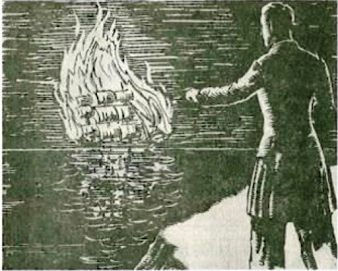Revised RQs and Current Works Cited
My research question was previously: Why are so many authors interested in ghost ships and what aspects of the phenomena make ghost ships a good topic for fiction and mystery literature? How does the truth about these ghost ships become clouded through these myths, legends, and stories that are written about them? How does a ghost ship actually become a ghost ship, what requirements define this term, what has actually happened to these ships regardless of how literature has affected their stories?
I think I would like to focus on the Palatine ship as my main example in my research, so instead of asking how a ghost ship actually becomes a ghost ship, I would like to ask how the Palatine ship has been a symbol of Block Island's past as well as analyze the legends/literature that have been written about the ship.
5 Scholarly Sources
"BURNING OF THE PALATINE: A PET SUPERSTITION AMONG BLOCK ISLANDERS. THE EERIE BLAZE APPEARS TO A PHILADELPHIAN--SCIENTIFIC EXPLANATION OF THE PHENOMENON." New York Times (1857-1922), Aug 15, 1885, pp. 3. ProQuest, https://login.proxy.libraries.rutgers.edu/login?url= ?url=https://www-proquest-com.proxy.libraries.rutgers.edu/historical-newspapers/burning-palatine/docview/94357435/se-2?accountid=13626.
Dalton, Anthony. Baychimo : Arctic Ghost Ship . Heritage House, 2006.
Fay, Charles Edey. Mary Celeste; the Odyssey of an Abandoned Ship. Peabody museum, 1942.
Jill Farinelli. The Palatine Wreck: The Legend of the New England Ghost Ship. University Press of New England, 2017.
King, Richard, and Horace Beck. “Ghosts and Ghost Ship Legends.” Encyclopedia of American Literature of the Sea and Great Lakes, 2001, pp. 152–56.


I still do not see a strong theoretical frame or analytic term emerging from your material. The most interesting in the literature you cite is the term "apophenia" from Farinelli (151-152), but she does not seem to do much with that idea in her analysis.
ReplyDeleteI found an interesting Master's dissertation, which talks about the Baychimo as being part of a "landscape of memory" (which the writer uses to frame the reading):
Allen, A. 2014. Alaskan Ghost Ships and Narrative Landscapes of Memory. M.A.
Thesis. Department of Geography, University of Wyoming. May 2014.
That might be a useful term for you also.